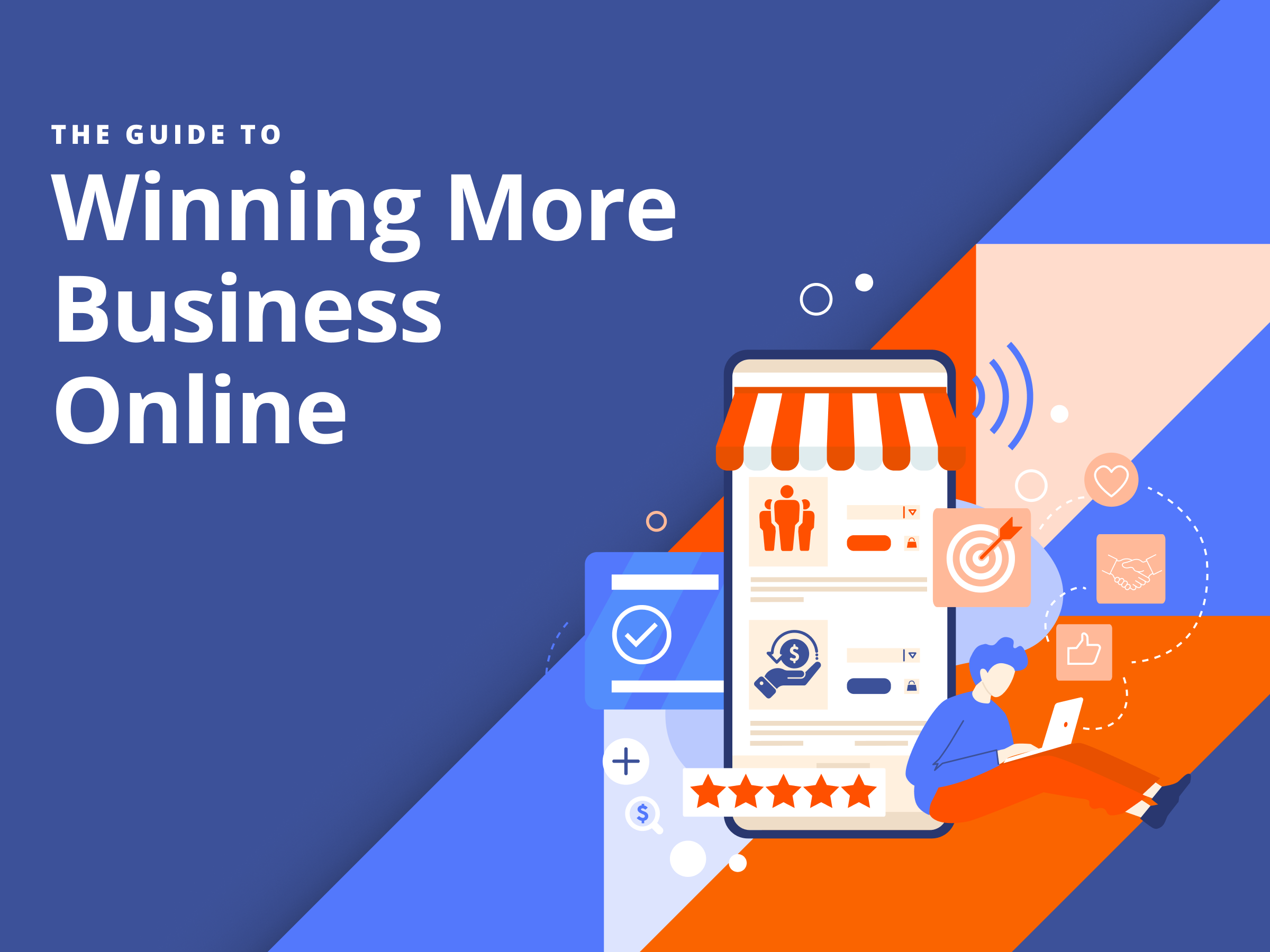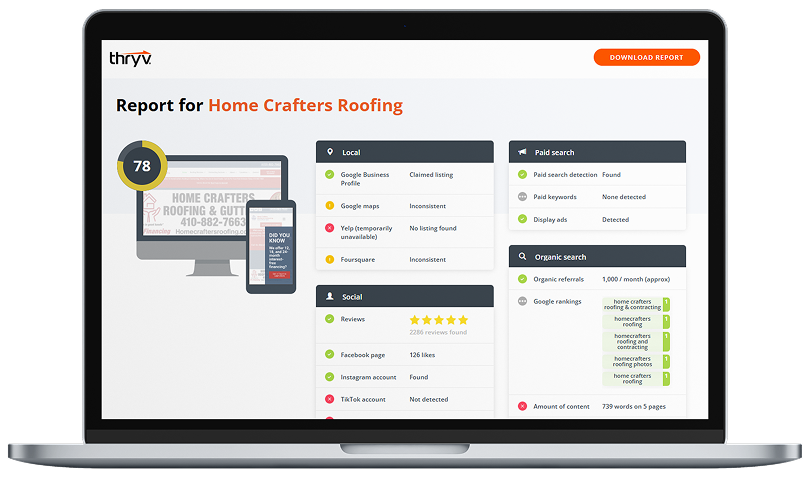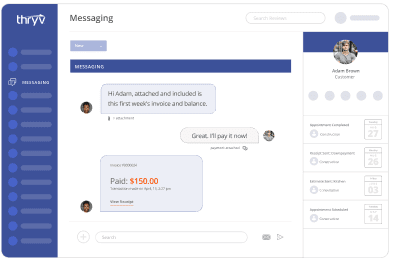Pay-Per-Click (PPC) advertising can feel overwhelming for small business owners, especially those who’ve never created online ads. There are several moving parts, and plenty of buzzwords and jargon that can make your head spin.
Whether managing your own campaigns or working with an agency, knowing common PPC terms is essential to making informed decisions and getting the most out of your marketing budget.

Free Guide: The Guide to Winning More Business Online
We’ll show you how to land more customers with a better website and online presence in this free ebook.
Download
In this post, we’ll break down the most important PPC terms in simple, clear language so you can confidently navigate the digital advertising world.
What are PPC terms?
PPC terms are the key phrases and jargon commonly used in pay-per-click advertising. These terms help describe how campaigns are set up, measured, and optimized across platforms like Google Ads, Bing Ads, and social media networks.
If you’re new to PPC, the terminology can sound like a foreign language — CPC, CTR, ROAS, Quality Score — what does all that mean? Understanding these terms is crucial because they directly impact your ad performance and how efficiently your marketing budget is spent.
Whethe setting up your first campaign or reviewing reports from an ad manager, knowing PPC terms gives you the clarity to ask better questions, spot opportunities, and avoid costly mistakes.
Now, let’s get to what you came here for. Here are some PPC terms that every small business owner should know.
PPC Terms: Your Complete Glossary
- Ad Extensions
- Ad Rank
- Conversion
- Conversion Rate
- CPC (Cost Per Click)
- CTR (Click-Through Rate)
- Impressions
- Landing Page
- Match Types
- Negative Keywords
- Quality Score
- Search Terms Report
- A/B Testing
- Attribution
- Bid Strategy
- Budget Pacing
- CPA (Cost Per Acquisition)
- Funnel
- Impression Share
- KPI (Key Performance Indicator)
- Lifetime Value (LTV)
- Remarketing (or Retargeting)
- ROAS (Return on Ad Spend)
PPC Search Terms
These PPC terms will help you navigate paid search. Paid search means advertising on search engines like Google. Your ad will appear at the top of the search engine results page (SERP) with a “Sponsored” tag above it.
1. Ad Extensions
You can add extra bits of information to your ad, such as phone numbers, site links, locations, or callouts. These are called “Ad Extensions,” and they make your ad more useful and improve click-through rates and Ad Rank.
The example below shows a “Contact Us” link; the location and hours are also listed.
2. Ad Rank
Ad Rank determines where your ad appears on the search engine results page. It’s calculated using your bid amount, Quality Score, and expected impact from ad extensions and other ad formats.
3. Conversion
A conversion is any valuable action a user takes after clicking your ad — like filling out a form, booking a call, or making a purchase. It’s the end goal of most PPC campaigns.
4. Conversion Rate
This is the percentage of users who clicked your ad and completed a desired action. A high conversion rate means your landing page and offer are compelling and aligned with what users were searching for.
5. CPC (Cost Per Click)
This is the amount you pay each time someone clicks on your ad. CPC varies based on competition for your keywords, your Quality Score, and bidding strategy. It’s one of the key metrics to watch to ensure your budget is spent efficiently.
6. CTR (Click-Through Rate)
CTR is the percentage of people who see and click on your ad. A higher CTR generally means your ad is relevant and engaging, which can improve your Quality Score and lower your CPC.
7. Impressions
An impression is counted every time your ad is shown to a user on the search engine results page. It doesn’t mean the user clicked; it just means your ad appeared.
8. Landing Page
This is the web page a user is taken to after clicking your ad. A strong landing page matches your ad’s message and makes it easy for visitors to convert, whether calling you directly, signing up online, or buying a product from your store.
Below is the landing page for the ad showcased in the “Ad Extensions” definition.
9. Match Types
Match Types decide how closely a person’s search must match your chosen keywords for your ad to appear. When you add a keyword to your campaign in platforms like Google Ads, you select which match type to apply. There are three main types:
- Broad Match shows your ad for the widest range of related searches. Use Broad Match to reach a wider audience.
- Phrase Match shows your ad when someone searches for a phrase that includes your keyword. Use Phrase Match to get more relevant traffic while reaching a decent range.
- Exact Match only shows your ad for searches that closely match your exact keyword. Use Exact Match when you want super-targeted traffic with minimal waste.
10. Negative Keywords
These are keywords you tell Google not to show your ads for. They help prevent your ad from appearing in irrelevant searches and wasting your budget.
Let’s say you’re a local HVAC company offering repair services but not selling HVAC parts.
If you’re bidding on the keyword “HVAC repair”, your ad might show up for searches like:
- “HVAC repair near me” (good match)
- “DIY HVAC repair parts” (not a good match)
To avoid wasting money on clicks from people looking for parts (which you don’t sell), you’d add “parts” as a negative keyword.
Common negative keywords for a service business might include:
- free (if you don’t offer free services)
- DIY
- cheap (if you’re premium-priced)
- jobs or careers (to avoid job seekers)
- wholesale
- used
Adding these as negative keywords tells Google: “Don’t show my ad if the search includes this word.”
11. Quality Score
Google assigns a score from 1 to 10 to each keyword in your account, based on three main factors: expected CTR, ad relevance, and landing page experience. A higher Quality Score can lead to better ad positions at lower costs.
12. Search Terms Report
This report shows the actual search queries that triggered your ads. It’s a great advertising tool for identifying new keyword opportunities or negative keywords to filter out irrelevant traffic.
Market and Grow Your Business More Effectively With Marketing Center
Marketing Center helps you attract new customers to your business and shows you which marketing strategies work best for your customers so you don’t waste time and money on the wrong tactics.

PPC Marketing Terms
These PPC terms will help you improve your marketing campaigns, analyze ad performance, and optimize messages across multiple channels.
13. A/B Testing
A/B testing compares two versions of an ad, landing page, or call-to-action to see which performs better. It helps you make data-driven improvements to your PPC campaigns.
Let’s say you’re running ads for your HVAC repair service and want to find out which ad gets more people to click and book an appointment.
You create two versions of your ad:
Ad A (Version 1):
Headline: “Fast, Reliable HVAC Repair – Book Today”
Description: “Serving your neighborhood 24/7. Affordable rates. Call now!”
Ad B (Version 2):
Headline: “24/7 Emergency HVAC Service – Call Now”
Description: “Certified technicians. Same-day repairs available. Get a free quote!”
You run both ads simultaneously with the same budget, targeting the same audience. After a week, you compare the results:
- Ad A CTR: 3.2%
- Ad B CTR: 4.8%
That tells you Ad B is more effective at getting clicks. You can pause Ad A and keep testing new versions based on what worked in Ad B.
A/B testing helps you improve your ads by comparing two versions and using real data (not guesswork) to decide which performs better.
14. Attribution
Attribution determines which parts of your marketing, like ads, keywords, or devices, deserve credit when someone takes an action, like making a purchase or filling out a form. It helps you understand what’s working in your campaign so you can make smarter decisions and improve your results.
15. Bid Strategy
Your bid strategy controls how Google or other platforms spend your budget to get clicks or conversions. Options include manual CPC, target CPA, maximize Conversions, and more, each suited to different goals.
Common bid strategies in Google Ads:
- Manual CPC (Cost Per Click): You set your maximum bid for each click. This offers the most control but requires more management and experience.
- Target CPA (Cost Per Acquisition): Google automatically sets bids to get as many conversions as possible at your target cost per lead or sale. This is great for lead generation or e-commerce with defined goals.
- Maximize Conversions: Google uses your budget to get the highest number of conversions possible without focusing on cost per conversion. This method is best when your goal is volume over efficiency.
- Maximize Clicks: Google aims to get the most clicks within your budget. This is useful if you want to drive traffic to your site quickly.
- Target ROAS (Return on Ad Spend): Bids are set to help you get the best return on your spending. This is ideal for e-commerce when you care most about revenue from each dollar spent.
- Enhanced CPC: This is a hybrid strategy. You set bids manually, but Google can adjust them slightly based on the likelihood of a conversion. This strategy is helpful if you want some automation but still want control.
16. Budget Pacing
This refers to how your daily or monthly PPC budget is spread out over time. Proper pacing ensures your ads don’t spend all the budget early in a day or month, leaving you with no visibility later.
17. CPA (Cost Per Acquisition)
CPA tells you how much you spend on average to acquire a lead or customer. It’s a critical metric for measuring the efficiency of your ad spend, especially in lead generation or e-commerce.
18. Funnel
The funnel represents the stages of a customer journey — from awareness to consideration to purchase. PPC ads can target people at different stages with tailored messages and offers.
19. Impression Share
Impression Share tells you the percentage of the available ad impressions your ads received. A low Impression Share indicates high competition or that your budget or bids are too low.
20. KPI (Key Performance Indicator)
KPIs are the most important metrics for measuring success. These include CPA, ROAS, CTR, and conversions. Tracking KPIs helps you stay focused on what matters most in your campaigns.
21. Lifetime Value (LTV)
LTV is the estimated total revenue a customer will bring over the course of their relationship with your business. Knowing your LTV helps you decide how much you can spend on acquiring a customer through PPC.
22. Remarketing (or Retargeting)
This strategy involves showing ads to users who’ve previously interacted with your website or brand. It’s a powerful way to stay top-of-mind and bring interested users back to convert.
23. ROAS (Return on Ad Spend)
ROAS measures how much revenue you earn for every dollar spent on advertising. For example, a ROAS of 4.0 means you earned $4 for every $1 spent. It’s key to understanding whether your campaigns are profitable.
Get Started with PPC Today
Pay-per-click advertising can be a powerful tool for small businesses, but only if you understand the language. You’ll be better equipped to manage your campaigns and evaluate performance by getting familiar with these essential PPC terms. Whether running ads yourself or working with an agency, this knowledge helps you make smarter decisions, avoid waste, and get the most value from every advertising dollar.

The Guide to Winning
More Business Online
We’ll show you how to land more customers with a better website and online presence in this free ebook.


